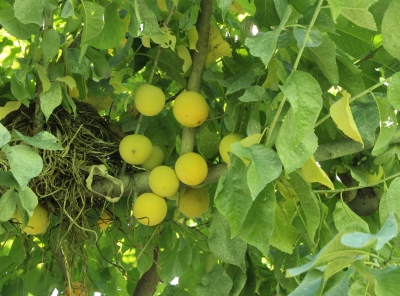GOLDEN REWARDS, NOW & FUTURE
/0 Comments/in Gardening, Planning, Vegetables/by Lee ReichWhy Grow Sweet Corn?
With all the supersweet, tender ears of corn readily available at farms, farmers’ markets, even supermarkets these days, why do I bother to grow my own sweet corn? Because it tastes better, much better. Corn can be too sweet, and too tender for many of us maizophiles.
I grow the variety Golden Bantam, which was the standard of excellent in sweet corn a hundred years ago. Its fat, golden kernels are toothsome, giving you something to chew on (but they’re not too chewy), with a rich, corny flavor. And yes, they are also sweet, just not supersweet.
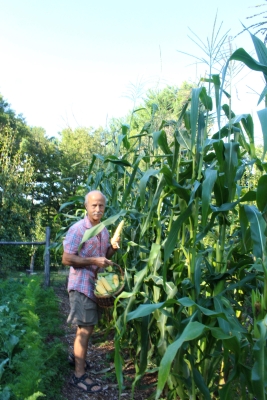 Corn is a relatively pest-free vegetable that warrants space in any garden. I grow corn in hills (clusters) of three plants each with 2 feet between hills in the row and two rows of hills down each 3-foot-wide bed. With each stalk yielding one to two ears, I reap 30 to 60 ears for each ten feet of bed! That’s a lot of ears, and it’s in space in which I sow early lettuce or spinach before planting the corn, and late turnips or, again, lettuce, spinach, arugula, or other cool season vegetables to follow the corn harvest.
Corn is a relatively pest-free vegetable that warrants space in any garden. I grow corn in hills (clusters) of three plants each with 2 feet between hills in the row and two rows of hills down each 3-foot-wide bed. With each stalk yielding one to two ears, I reap 30 to 60 ears for each ten feet of bed! That’s a lot of ears, and it’s in space in which I sow early lettuce or spinach before planting the corn, and late turnips or, again, lettuce, spinach, arugula, or other cool season vegetables to follow the corn harvest.
Of course, I plant more than just one 10 foot bed of corn and I spread the harvest season with successive sowings, 4 of them 2 weeks apart.
There is one limitation to backyard corn: raccoons. Given the opportunity, they will harvest every ripe ear. Trapping is one way to keep them at bay. My dogs, Sammy and Scooter, spend day and night frolicking outdoors — and convincing raccoons to search for greener pastures.
GMO and Crap Shooting
Golden Bantam corn, because it originated in 1906, is, of course non-GMO, that is, a “non genetically modified organism.” (As of now, almost all commercial sweet corn is still non-GMO; just about all field corn, which makes its way into animals, corn syrup, and more packaged products than you can imagine, is GMO.) This is my lead-in to clearing up some basic misconceptions about what GMO means.
When the pollen from any plant lands on the female part of a flower of another plant, cross-pollination occurs. The resulting seeds and the plant growing from those seeds carry genes contributed from each of the two parent plants. As a result, the offspring are similar to, but not genetically identical, to the parents. The offspring is a natural hybrid.
Enter Homo sapiens . . . Since the dawn of civilization, we humans have sought certain traits in our plants. To get plants with such traits, we chose plant parents having qualities to our liking and deliberately mated them in the hopes that their offspring would pick up only the parents’ good traits. The more offspring that are grown, the better the chance of finding a hybrid — one produced with human assistance, in this case, possessing desirable traits.
Besides the crapshoot of traditional breeding, success is further limited by our only being able to choose from among plant parents that are related closely enough to breed. For instance you could not mate a tomato plant, which is not frost tolerant, with, say, a flounder, a fish very tolerant of freezing temperatures, in an effort to make a frost tolerant tomato. Tomatoes and fish are not even distant kin and could never breed with each other under natural conditions.
About 30 years ago, scientists developed methods for circumventing the capriciousness of natural or human-assisted breeding. Laboratory methods were developed for teasing a desirable gene out of a cell of one organism, then injecting the gene into cell of another organism to create new organism — a GMO. And I do mean a “new organism,” because it contains genetic material that need not have come from a related organism.
That “fish tomato” was, in fact, created by incorporated the so-called antifreeze gene from winter flounder into a tomato. It turns out that gene expression is not as straightforward or as predictable as once imagined. The fish tomato was a commercial flop in its frost tolerance and other agronomic characteristics; perhaps it would have been a good swimmer.
Since that fish tomato came and went, other GMOs have been developed. Many have been commercial successes.
Just to be clear: While it is true, as is often stated in support of GMOs, that hybridization or cross-breeding has been going on in nature for eons, that cross-breeding has always been between closely related species. Humans intervened, but nature could also have produced those traditional hybrids.
All the above involves, in some sense, genetic modification. You are a genetic modification of your parents. But the term “genetically modified organism,” or GMO, genetically engineered, or transgenic organism, signifies an organism that has picked up genes via manipulation in a laboratory, often genes that never could have showed up naturally in the organism.
Some Summer in Winter
I awaited my first taste of this season’s Golden Bantam with more anticipation than my first taste of tomato. Finally, we’re awash in sweet corn, more than we can eat.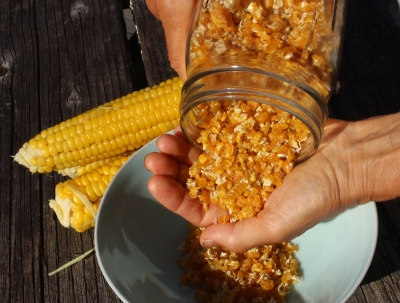
But six weeks of sweet corn will not satisfy, so we’re packing away some for winter. Steaming or boiling the shucked cobs arrests enzymes that change kernel’s sugars to starches. With sweetness retained, we slice kernels from cobs, then either freeze them or dry them. Either way, they are a flavorful addition to soups, stews, and breads on dark, cold, winter days. But nothing like biting into a freshly steamed cob in the heat of summer sun.
For More, Live . . .
Check out my upcoming lectures for the weeks and months ahead at https://leereich.com/lectures
MAYPOP & ASPARAGUS, BEAUTIFUL & EDIBLE
/22 Comments/in Design, Flowers, Fruit, Gardening/by Lee ReichAwesome, Made More So
You would think — or I, at least, would think — that a purple and white passionflower would be more passion-inducing than one that was merely white. Not so. The white one displays a passionate juxtaposition between a pure, lily-whiteness and a wildness from the the squiggly, threadlxike rays of its corona backdropping female stigmas’ that arch over the yellow pollen-dusted anthers.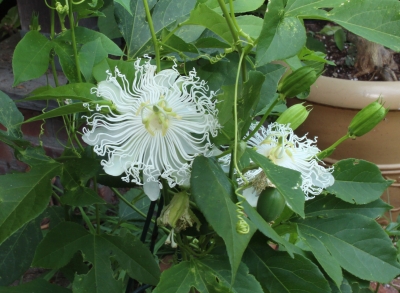
A white passionflower is a rarity. Mine sprung up by chance from a batch of seeds I planted last year. Mostly the plants bear purple and white flowers.
Most passionflowers are tropical, but this white-flowered passionflower, like its mother and siblings can survive outdoors even with our winter lows of well below zero degrees Fahrenheit. Commonly known as maypop, Passiflora incarnata is native to eastern U.S. as far north as Pennsylvania. Tropical passionflowers, are woody perennial vines; maypop is an herbaceous perennial vine, dying back to the ground each fall, but sprouting each spring from its perennial roots.
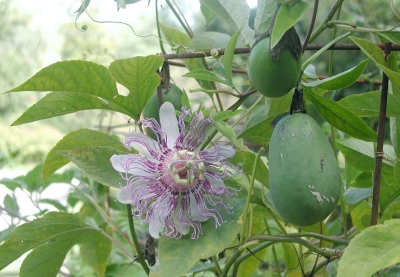 Vine growth begins late, typically not showing until early June here in the Hudson Valley. Summer warmth coaxes it along to begin flowering in July. Once the flowers appear, they continue almost nonstop through the summer until fall, with one to a few new flowers opening each day.
Vine growth begins late, typically not showing until early June here in the Hudson Valley. Summer warmth coaxes it along to begin flowering in July. Once the flowers appear, they continue almost nonstop through the summer until fall, with one to a few new flowers opening each day.
Fruits soon follow the flowers. Yes: Fruits! Passionfruits are delicious, and maypop fruits taste pretty much the same as tropical passionfruits — the main flavor in Hawaiian punch, in case you think you’re unfamiliar with the fruit. The fruit is egg-shaped, its interior packed full of seeds, each of which is surrounded by a thick coat of deliciousness, in much the same way as pomegranate seeds.
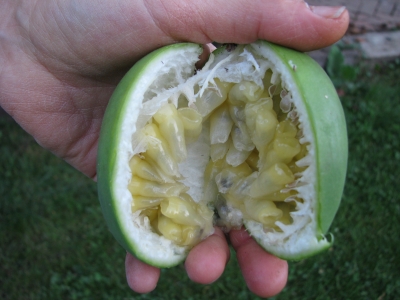 I haven’t figured out where to plant my maypops, so they’re still in large pots. Years ago, I had a couple in the ground at the base of a lilac tree. The maypops climbed into the lilac to put on a show through summer, after the lilac itself was no longer interesting. Now I want a fence for it to clothe in a heat-capturing spot in full sunlight. Maypop does spread underground, to the extent that it’s considered a weed in the Deep South, where it really can run wild. Spread is less here, but still, I need a location for it that takes that potential into account. Alternatively, I’ll plant it in a deep, bottomless container, such as a chimney flue.
I haven’t figured out where to plant my maypops, so they’re still in large pots. Years ago, I had a couple in the ground at the base of a lilac tree. The maypops climbed into the lilac to put on a show through summer, after the lilac itself was no longer interesting. Now I want a fence for it to clothe in a heat-capturing spot in full sunlight. Maypop does spread underground, to the extent that it’s considered a weed in the Deep South, where it really can run wild. Spread is less here, but still, I need a location for it that takes that potential into account. Alternatively, I’ll plant it in a deep, bottomless container, such as a chimney flue.
The Other Kind of Passion
If truth be told, the “passion” that gave passionflowers their name refers to a religious passion, the passion of Christ. The plant was a seventeenth-century teaching tool for spreading the gospel.
Passionflower “had clearly been designed by the Great Creator that it might, in due time, assist in the conversion of the heathen among which it grows,” wrote a Christian scholar of the seventeenth century. The ten so-called petals (botanically, five petals and five petal-like sepals) were taken to represent the ten apostles present at the crucifixion. The threadlike rays of the corona were taken for symbols of the crown of thorns. The five stamens and three styles referred, respectively, to the five wounds of Christ and the three nails used in the crucifixion. Even the rest of the plant figures in, with the three-lobed leaves representing the Trinity and the tendrils representing the scourges. 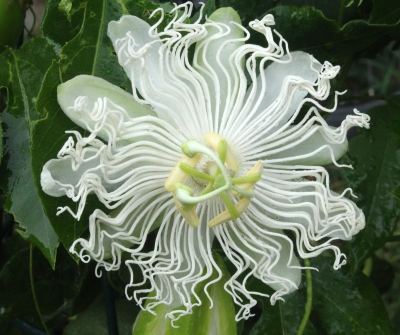
Passionflowers are heavenly enough to bring on a religious devotion to growing the plants. Which brings us to sex . . . The flowers are andromonoecious, which means that on every plant some flowers are perfect (have functioning male and female flower parts) and some are functionally male. Functional males have female parts but are functionally male either because their stigmas are held upwards out of the way of insect visitors or because their female parts are atrophied. So grow two plants if insects are to do your bidding, one plant if you’ll take care of pollination.
See my book Uncommon Fruits for Every Garden for more — a whole chapter! — on hardy passionfruits.
“Sparrowgrass” Need Help
My asparagus is now a six-foot-high, ferny hedge outside and along the eastern edge of one of the vegetable gardens. It’s a pretty sight until my eyes drop downward to see the weeds sprouting at the “hedge’s” feet. Not that the weeds are putting the brakes on the asparagus, but they are making seeds that then spread into the vegetable garden.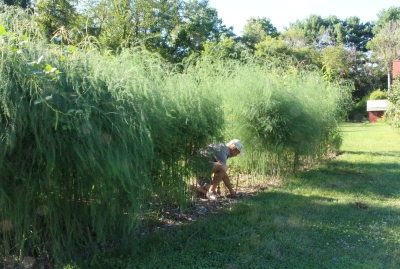
I’ve seen gardens and farms where asparagus beds were abandoned because of weeds. Mulching and early season weeding only go so far.
The usual recommendation for growing asparagus is to purchase roots and plant them at the bottom of a deep trench. As new shoots grow, the trench is gradually filled in with soil.
More recent research showed that such heroic efforts were unnecessary. I planted my asparagus just deep enough to get them into the ground.
The reason for trenching asparagus was to get the crowns low enough so that a tiller or hoe could be used to kill weeds without damaging the crown. All of which is impossible when the crowns are planted with their buds just beneath the surface.
So these days I’m periodically crawling into the hedge, becoming very intimate with the ground there, and pulling out all the weeds.
SUNNY DAYS & YOGA, BUT TOMATOES?
/5 Comments/in Fruit, Gardening, Pests, Vegetables/by Lee ReichSpringtown Farmden Health Spa
In the past, I have written of rei-king and sie-thing as two of the many healthful exercises offered here at Springtown Farmden Health Spa. We now have a new offering at the spa: garden yoga or, more catchy, gardoga or yōgdening. I like the last one best.
Yōgdening grew out of my respect for the soil, my desire to maintain and foster a healthy balance of life below ground. A healthy population of bacteria, fungi, worms, actinomycetes and other below-ground dwellers translates to healthy plants above ground. Those beneficial creatures need to breathe, which is why most gardeners and farmers till their soil. To aerate it.
But tilling a soil also burns up valuable organic matter. This organic matter feeds soil organisms and, in turn, plants, makes nutrients already in the ground more accessible to plants, helps hold moisture for plants, and helps aerate the soil.
I avoid the need to till my soil for aeration by almost never walking, rolling a wheel barrow, or allowing any other traffic where plants are growing. Plants in fields and forest grow well despite never being tilled except what earthworms and other small animals manage to do. (No small amount: Charles Darwin computed that earthworms completely turn over the upper six inches of a pasture soil every 10 to 20 years — in England, at least.)
Getting back to yōgdening . . . Weeds are making inroads into certain parts of my gardens. Not my vegetable gardens, the 3-foot-wide plant beds of which I keep well weeded with my feet firmly planted in the 18-inch-wide paths bordering the beds. But the only way I can reach into some other planted areas, a bed of various flowers sprawling beneath some Asian pear espaliers, for example, is by stepping into them. To minimize foot traffic, after stepping into a planted area, I try to keep my foot anchored in place, from which I pull every weed I can reach.
As you might imagine, reaching every weed possible with feet planted in one place calls for all sorts of contortions and stretches forwards, backwards, and sideways involving my legs, trunk, shoulders, arms, and neck. My guess is that after a half-hour of weeding, I’ve run through a close approximation of Utthia Trikonāsana (Triangle Pose), Vīrabhadrāsana (Warrior Pose), and Uttānāsana (Standing Forward Fold Pose), to name a few classic yoga poses — and cleared away weeds!
Weeding (or, perhaps, I should write “we-ding,” another spa offering) is especially satisfying this time of year. Dry weather has slowed sprouting of new weeds so cleared areas remain clear.
Brown Rot Not (Too Much)
Dry weather is also good for fruit ripening. That is, ripening rather than rotting. As sweetness develops in ripening fruits, they become more susceptible to rotting. Fungi, like humans, can make quicker use of simple sugars than more complex carbohydrates, such as a are found in unripe fruits. Fruits with thin skins are especially susceptible to attack from fungi.
For a variety of reasons, known and unknown, this has been a good year for plums. In past years, late frosts in spring have snuffed out blossoms or plum curculio has caused many, if not all, plumlets to rain to the ground. This year, blossom buds were unscathed from winter cold or spring frosts, curculios were kept at bay by my spraying Surround, a commercial product that is nothing more than kaolin clay.
Current dry weather should also limit plums’ other nemesis: brown rot, a fungal disease that turns ripening fruit gray and fuzzy and then, at the end of the season, into dark brown, shriveled mummies. (Of course, beautiful clear days are often followed by clear nights during which water, in the form of dew, condenses on fruits and leaves.) The mummies hang from the branches, along with cankers on branches, spread spores and infection the following year. Fallen mummies are also a source of the following season’s infection.
Brown rot gets to work early in the season, around blossom time, and then later in the season, as fruits are ripening, which is now, for my Shiro plums. Early in the season, I added sulfur, a naturally mined mineral whose use as a fungicide goes back to the ancient Greeks, to the mix when I was spraying Surround.
Supplementing that spraying was cleaning up hanging and fallen mummies at the end of the season, and promoting drying of branches and fruits with pruning and thinning out of excess fruits.
The upshot is that some brown rot is showing up on ripening plums. But not all of them. And those that have been spared are delectable. Even the birds think so. Their peckings, unfortunately, like wounds inflicted by plum curculios, increase fruits’ susceptibility to brown rot.
Tomatoes, Where Are You?
Tomatoes are growing like gangbusters, here and in other gardens I’ve seen locally. And the fruits are likewise growing very plump.
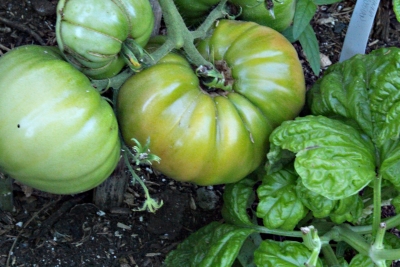 But the scene is not as rosy as it should be, literally, because too many of the tomatoes are still green. Again, other local gardens mimic my experience. How are your tomatoes doing this year?
But the scene is not as rosy as it should be, literally, because too many of the tomatoes are still green. Again, other local gardens mimic my experience. How are your tomatoes doing this year?
Day after day of bright sunny, weather and moderate temperatures should have promoted ripening. Then again, day after day of rainy weather last month might have retarded it. At any rate, in gardening and farming, you can’t go wrong blaming the weather.


